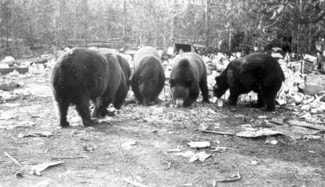It is, of course, the Whitehorse waterfront.
The photograph came from the Jim Robb collection and was probably taken in the late 1930s, or early 1940s.
Many thanks to Bob Cameron, “the Yukon’s No. 1 vintage airplane authority,” and Robert Austin for their replies.
They read:
Hello Jim,
The aircraft in your CFP photo of the November 5 Yukon News is a 1923 Junkers F-13.
It was the product of the brilliant German professor Dr. Hugo Junkers, who started building the all-metal monoplanes in 1920, at a time when the rest of the world was still building wood and fabric biplanes.
He was eons ahead of everyone else!
In May of 1930, Junkers CF-AMX was purchased by the Vancouver-based Air-Land Manufacturing Company of Vancouver, and sent north to do charter work out of a base at Atlin, BC. The crew was pilot E.J.A. “Paddy” Burke, and maintenance engineer Emil Kading.
In October of that year, Junkers CF-AMX became the subject of one of the longest air searches in Canadian history.
Burke, Kading, and their passenger, prospector Bob Martin, had left Atlin for Liard Post on October 9.
The flight over was uneventful, but on the return trip, which began on October 11, they ran into a series of snowstorms, forcing them to set down (on floats) on the Liard River a number of times.
On the last weather-forced landing, the floats struck rocks in the river, rendering the aircraft unflyable.
And so began, as winter set in, a desperate survival ordeal for the three men, and a search and rescue effort that took 61 days.
During the search, several aircraft were lost, including a float-equipped Lockheed Vega, which was never found.
On November 23, Paddy Burke died of starvation and exposure, as the desperate trio tried to hike to a known food cache at Wolf Lake.
On December 6, after eight weeks of doggedly-determined searching, pilot Everett Wassen, flying the Treadwell Yukon Fairchild G-CARM, (which has been featured several times in your CFP columns) spotted the two haggard survivors, and four days later had them safely in Whitehorse.
It took another seven days of hard work to retrieve Burke’s body. He is buried in Atlin.
I have been very brief here, relating the saga of the search for CF-AMX.
It is an incredible story of drama, heroism and tragedy.
Your photo depicts AMX on the Yukon River, just upriver from the shipyards (about where Kanoe People and the city’s storm sewer outlet are today).
The date would be 1930.
Regards,
Bob Cameron
The picture appears to have been taken on the west side of the Yukon River — as one faces northward on the Whitehorse side.
It looks like the shot was taken long before the road was cut into the opposite side of the bank; now a road there leads to Long Lake with trails that eventually ended up at the old sawmill site.
I must admit I would not be willing to stake my life on the setting.
On the other hand, I am a little more certain about the plane.
The plane CF-AMX was a Junkers
F-13.
It was used by the Air-Land Manufacturing Company and eventually sold to Pacific Airways.
The plane was scrapped in the late 1930s.
Cheers,
Robert Austin
